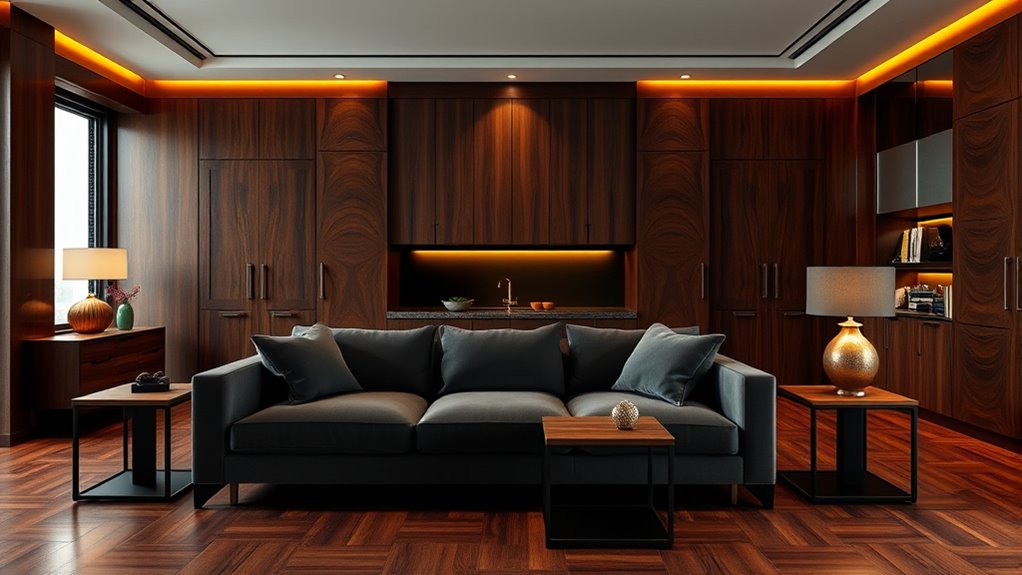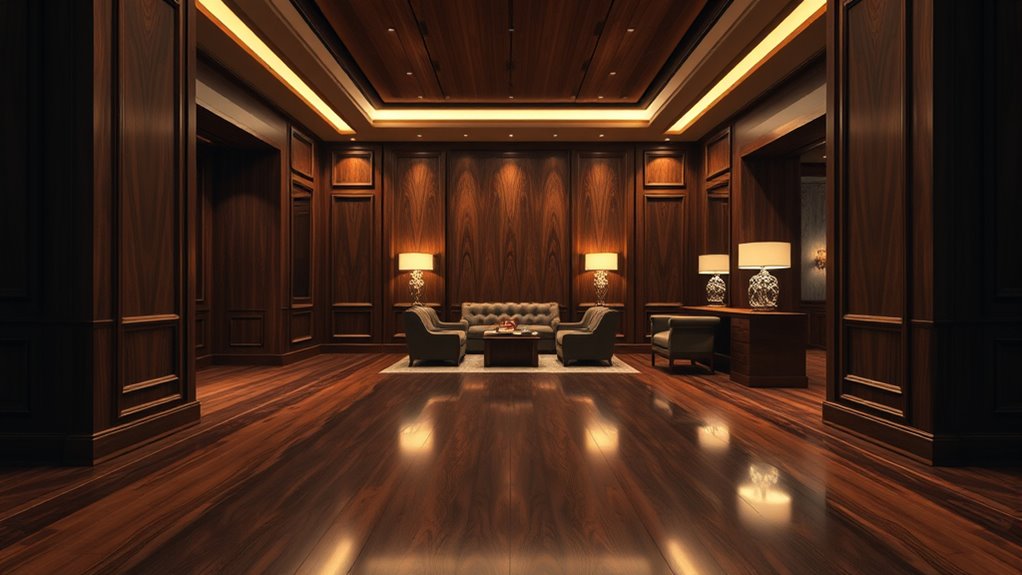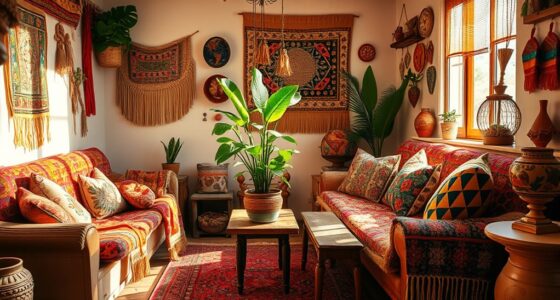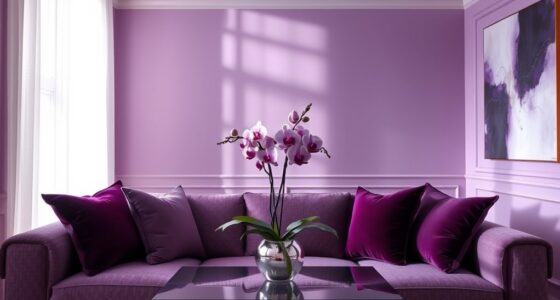To create warm, luxurious spaces using darker wood tones, focus on pairing rich woods like mahogany or walnut with bold jewel hues or neutral shades that highlight their depth. Incorporate contrasting textures such as plush fabrics, leather, or woven accents to add visual interest and prevent heaviness. Proper lighting, whether natural or warm artificial, highlights warm undertones and enhances the overall ambiance. Keep exploring to discover even more ideas on how to elevate your space with dark wood accents.
Key Takeaways
- Use rich, dark wood tones like mahogany or walnut to create a warm, sophisticated foundation in your space.
- Pair dark woods with deep jewel tones or neutral shades to enhance depth and visual interest.
- Incorporate contrasting textures such as plush velvet or woven textiles to prevent flatness and add tactile appeal.
- Maximize natural or warm lighting to highlight the warm undertones of dark wood furnishings.
- Integrate natural materials like stone or linen for an authentic, curated, and luxurious aesthetic.

Adding darker wood tones to your space can dramatically elevate its style, creating a warm and sophisticated atmosphere. These deep hues bring a sense of richness and depth, transforming an ordinary room into a luxurious retreat. To maximize this effect, focus on combining rich color palettes with contrasting textures. Dark woods like mahogany, espresso, or walnut serve as the perfect foundation, offering a bold, grounding presence that anchors your design. When paired with vibrant or muted palettes, these tones can create striking visual interest. Think of pairing a deep espresso table with plush velvet cushions or a sleek walnut floor with soft, textured rugs. The contrast between the smooth, polished wood and other textured materials adds dimension and keeps the space from feeling flat or monotonous.
Darker wood tones elevate your space with richness, depth, and sophisticated contrast for a luxurious, inviting atmosphere.
You’ll find that incorporating contrasting textures is key to making dark wood tones feel inviting rather than overpowering. Mix materials like leather, linen, and wool with your wood furnishings to add tactile variety. For example, a leather armchair against a dark wood accent wall creates a luxurious look that invites touch and comfort. Similarly, layered textiles—think textured throws or woven baskets—break up the visual heaviness of the dark wood and introduce subtle lightness. This interplay of textures enhances the richness of your space, making it feel curated and thoughtfully designed.
When selecting your color palette, lean into colors that complement and highlight the dark wood tones. Deep jewel tones such as emerald, sapphire, or ruby work beautifully, providing a regal touch. Alternatively, neutral shades like warm beiges, soft grays, or creamy whites can create a serene backdrop that emphasizes the depth of the wood. Keep in mind that lighting plays a pivotal role—ample natural light or well-placed warm bulbs can bring out the warm undertones of darker woods, preventing the space from feeling too heavy or gloomy.
Incorporating natural materials such as linen, wood, and stone is essential in achieving an authentic farmhouse aesthetic that harmonizes beautifully with dark wood tones. You’re encouraged to experiment with these elements until you find a balance that feels personal and refined. Incorporate dark wood accents through furniture, cabinetry, or decorative pieces, and layer in contrasting textures and rich colors to give your room a curated, luxurious vibe. With thoughtful choices, dark woods can serve as the perfect canvas to showcase your style—elegant, inviting, and undeniably sophisticated.
Frequently Asked Questions
How Do Darker Wood Tones Impact Room Acoustics?
Darker wood tones can influence your room’s acoustics by increasing sound absorption, reducing echo and noise. They tend to absorb more sound compared to lighter woods, creating a cozy atmosphere. However, if not balanced with other materials, they can also cause acoustic reflection, leading to sound bouncing that might make the space feel less clear. Proper placement and mixing with soft furnishings help optimize sound quality.
Are Darker Woods Suitable for Small Spaces?
Darker woods can work well in small spaces if you use them wisely. While some worry about making a room feel cramped, you can create striking color contrast by pairing dark furniture with lighter walls or accents, enhancing depth without overwhelming. Focus on strategic furniture placement and reflective surfaces to keep the space feeling open. With thoughtful furniture pairing, darker woods add sophistication without sacrificing the room’s sense of spaciousness.
What Maintenance Is Required for Dark Wood Finishes?
You should regularly clean dark wood finishes with a soft, damp cloth to remove dust and dirt, avoiding harsh chemicals. Use a gentle wood cleaner for deeper cleaning when needed. To preserve the finish, apply a quality wood polish or wax every few months, which helps protect against scratches and maintains the rich color. Avoid excessive moisture and direct sunlight, as these can damage the finish over time.
Can Darker Woods Be Mixed With Other Materials Effectively?
Absolutely, darker woods can transform your space into a stunning masterpiece! You’ll create a jaw-dropping contrast with light fabrics and seamlessly blend with metals for a modern, sophisticated look. Mixing these materials adds depth and personality, making your interiors feel rich and inviting. Just be bold—trust your eye—and experiment with different textures and finishes. The result? A beautifully balanced space that screams luxury and style.
How Do Dark Wood Tones Influence Room Lighting Choices?
Dark wood tones greatly influence your room’s lighting choices by enhancing lighting enhancement and adding design versatility. You’ll want to incorporate layered lighting, like warm LEDs and accent lights, to highlight the rich hues and create a cozy, inviting atmosphere. Dark woods absorb more light, so balancing natural and artificial lighting is key. This approach ensures your space feels warm, luxurious, and visually balanced, showcasing the depth of the wood tones effectively.
Conclusion
Incorporating darker wood tones instantly adds warmth and luxury to your space, creating a cozy yet sophisticated atmosphere. Did you know that homes with darker wood accents can increase perceived value by up to 12%? So, don’t hesitate to embrace these rich hues—whether through furniture, flooring, or accents—to elevate your space’s elegance and comfort. With the right touches, you’ll create a stunning environment that feels both inviting and opulent.









